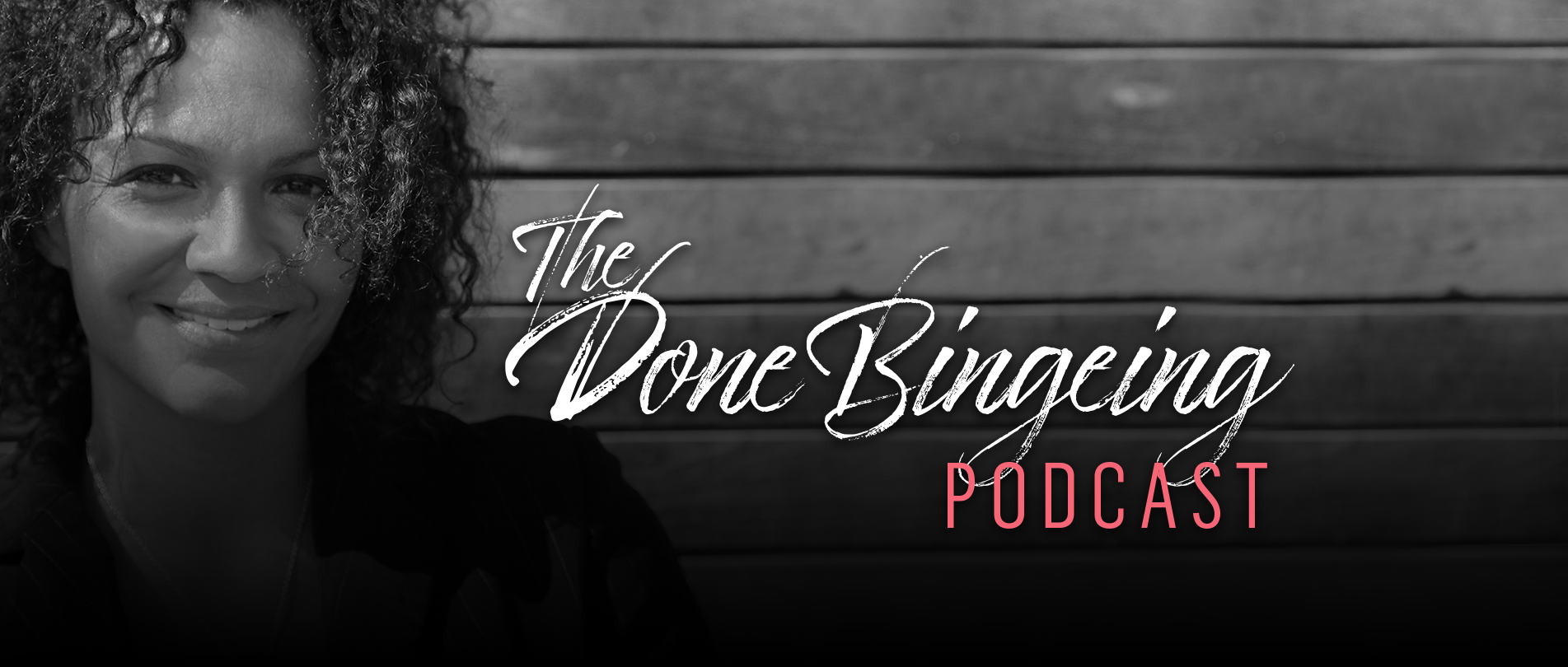
EP #14: Eating feelings VS. feeling feelings
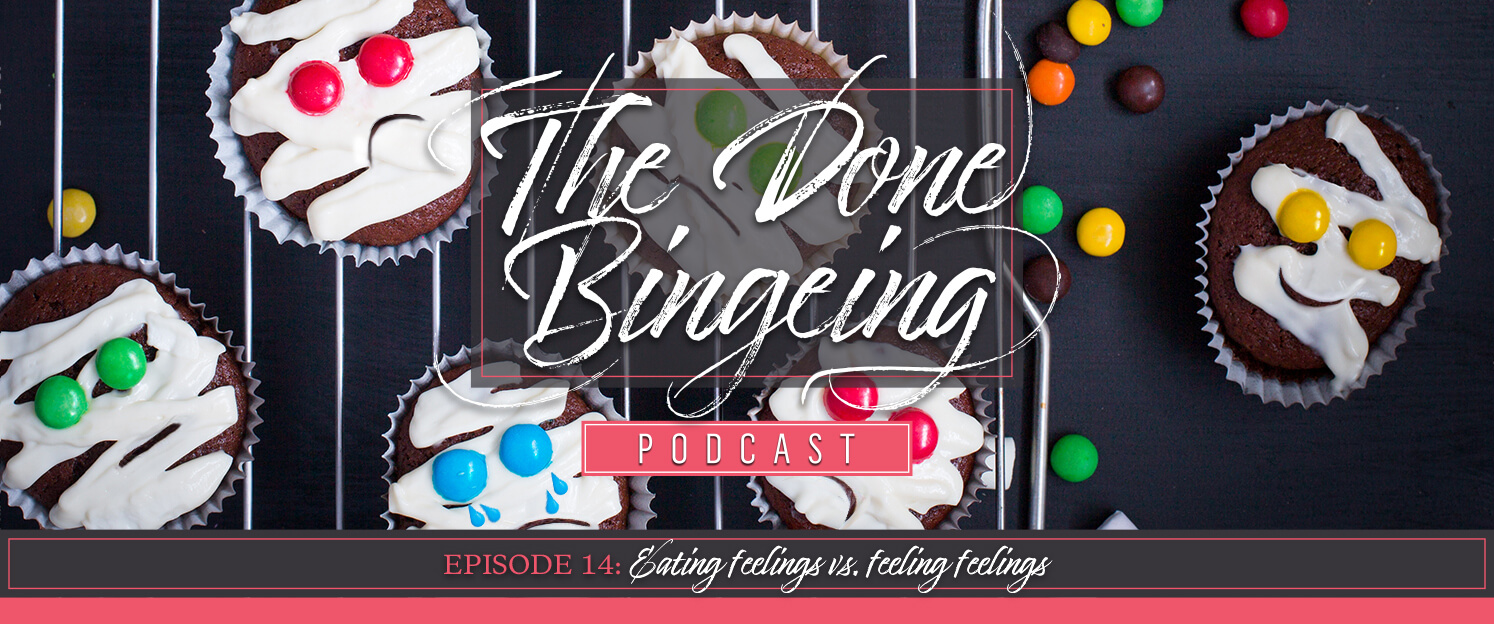
Sometimes feelings suck. Especially when you don’t want to feel them. One of the main reasons we have the desire to overeat is that overeating is an effective—though temporary—pain killer of feelings we don’t want to feel. The fact that it has the effect of doing what we want it to do—numb painful emotions—even for a short time is what keeps reinforcing its use as an analgesic. Episode 14 drills down even further into emotional eating.
In this episode, we continue the discussion we began in Episode 3 about using self-regard as your key ally to end your binges. Self-regard can help you deal with your unhappiness with your weight, the temptation to diet to lose that weight and control your eating, your urges to binge, the bingeing itself, and weight loss after you stop bingeing.
Get full show notes and more information here: https://www.holdingthespace.co/14
Episode: Play in new window
Subscribe: iTunes | Google Play | Stitcher | RSS
- Why you eat to dull emotional discomfort.
- The difference between eating your feelings versus feeling your feelings.
- The proposition you probably face when you want to eat emotionally—and how to make it a win–win.
- Why you want to practice being uncomfortable.
- What there might be a message in the misery.
- Tony Horton
- Brooke Castillo
- Book a free, private coaching session.
What do 25 burpees and dropping the f-bomb have to do with losing weight? Keep listening!
Welcome to The Done Bingeing Podcast. This is the place to hear about how you can pair emerging brain science about why you binge with powerful life coaching to help you stop. If you want to explore a non-clinical approach to end binge eating, you’re in the right place. It’s time to free yourself. You have more power than you know. And now, your host, Life and Weight-Loss Coach Martha Ayim.
Welcome to Episode 14 of The Done Bingeing Podcast. I’m so happy you’re here with me.
I spent this past weekend at the World Fitness Expo, a conference of 5000 delegates learning from the researchers at the cutting edge of what it takes to be healthy and fit. The keynote was delivered by Tony Horton, considered by some to be one of the most influential leaders in health and fitness. You may recognize him as the creator of P90X or his more recent 22-Minute Hard Corps military-style workout.
There were countless takeaways from Tony and the conference and I’m going to share so much with you in upcoming episodes. But the one that was perhaps the most indelible was a side comment Tony made about trying to find dinner the night he flew in to Toronto, tired and hungry. He had a menu and nothing on it that matched what he was committed to eating. He scanned and re-scanned that menu and negotiated with the kitchen until he could order something that would deliver a nutritious meal.
And he didn’t just get to do that because he was Tony Horton. And that’s one thing he said to us. We all can do that. We all can ensure we get the food we need.
He could have let exhaustion and frustration resign him to eating food that didn’t serve his body’s needs. But he didn’t. He used motivation and commitment to stay the course until he found food that served his body’s needs.
No, I’m not going to ask you to rigidly adhere to a diet. And, no, I’m not going to ask you to drop and give 25 burpees.
I’m sharing this to show how at 59, at the top of his game, at the top of the industry, Tony Horton still faces the same choice we face every day: Do we eat to fuel our body or do we eat to make something uncomfortable go away?
Have you ever said to someone, “Jeez, I just don’t know why I ate that. I just don’t know why I keep overeating”?
Here’s what my teacher and coach, Brooke Castillo, would say to you: “Stop overeating and the reason why you overeat will become really, really clear, really, really fast.”
Not overeating is the easy part.
What comes after you stop is the hard part.
Why is it hard? Because of the mother-load of reasons why you overeat in the first place. It could be to avoid the urge, which we’ve talked about in earlier episodes. Or it could be to dull a feeling you don’t want to feel—and that’s what we began to unpack in last week’s episode on emotional eating.
I get it.
Sometimes feelings suck. Especially when you don’t want to feel them. It’s like they’re the new f-word.
These days we’re pretty motivated to avoid discomfort. But back in the day, we must have been good at managing discomfort or we’d never have survived the caves. We didn’t have a choice. It was winter and we had a little hide covering our tushie and no Posturepedic mattress to sleep on. Ouch! And . . . ouch.
Now, it’s so much easier to avoid pain. It’s the foundation of our consumer society. We consume to avoid discomfort, right? We consume with our mouths, we consume with our eyes, we consume with our wallets.
One of the main reasons we have the desire to overeat is that overeating is an effective—though temporary—pain killer of feelings we don’t want to feel. The fact that it has the effect of doing what we want it to do—numb painful emotions—even for a short time is what keeps reinforcing its use as an analgesic.
Do you overeat to dull emotional discomfort? Let’s find out.
What would you feel if you wanted to overeat, but didn’t? And I don’t mean when you’re on some kind of whacked-out starvation diet. If you’re on one of those diets, you’re probably undereating and then overeating as a reaction to nutritional deprivation. What I’m talking about is when you’re well nourished and you simply decide you’re not going to eat any more than you need even though you’d really love to.
What would you feel?
Why would you feel that way?
Do you know?
Do you want to know?
Maybe you eat back-to-back brownies when you’re bored.
Now, think about the proposition here.
“Hey, I can have brownies or I can be bored! Hmm. Brownies. Boredom. Let me think about that one—okay, I’ll take the brownies!”
Right?
Maybe you eat ice cream when you’re irritated.
What’s the proposition here?
“Hey, I can have ice cream or I can be irritated! Let’s see . . . Ice cream. Irritation. Ice cream. Irritation. I’ll take four scoops please!”
Yes?
Maybe you eat Pop-Tarts when you’re pissed.
“Hey, I can have Pop-Tarts or I can be pissed! Gee, that’s a tough one. Where’s the toaster?”
Am I right?
Maybe you eat buttered Saltines when you’re sad.
“Hey, I can have Saltines or I can be sad! Oh, forget it, I’m gonna eat those salty squares.”
Am I close?
Maybe you eat French fries when you’re afraid.
“Hey, I can have fries or I can be afraid! Gosh, I’m having a real hard time deciding on that one. Pass the ketchup, please!”
Did I nail it?
If I did, it’s only because this is exactly what I did for more than 30 years. I ate my feelings. I felt like the only other option was to let my feelings eat me.
It’s a tough proposition.
But I have a suggestion. And I’m just warning you . . . you may not like it.
Choose discomfort.
Go for boredom over brownies.
Go for irritation over ice cream.
For pissed over Pop-Tarts.
For sadness over Saltines.
For fear over fries.
Are you still there?
If you’re still listening, I want you to know that I’m not saying this will be easy.
It’s going to be hard at first.
But you can do hard things.
And what’s the payoff?
Freedom.
That’s what.
Short-term discomfort for long-term freedom.
It’s a tough sell. But it will change. your. life.
And nearly sixty years of research backs me up.
Have you heard of The Marshmallow Experiment?
It was a series of studies that began in 1960, led by psychologist Walter Mischel. In these experiments, a child entered a room with no distractions and was given a choice. They could get a small reward, like a marshmallow, right away. Or, if they waited for about 15 minutes, they could get a bigger reward, like two marshmallows. Now, think back to when you’re a kid. Two marshmallows is a big deal!
Mischel noted that the kids would do just about anything to try to ride out those 15 minutes. Some would cover their eyes with their hands. Some would turn their backs on the marshmallow so they couldn’t see it. Some kicked the desk it was on. Some pulled on their pigtails or began to pet the marshmallow. Studies that followed up on these children found that the ones who waited for the bigger reward tended to have improved life outcomes. For example, better educational achievement and better health and better overall competence in their life (Shoda, Mischel, & Peake, 1990).
Ultimately, this was a test of delayed gratification. Short-term discomfort for long-term payoff.
Now, I’m not suggesting you pull your hair out or drop-kick your kitchen table the next time you try to ride out some annoyance. But what I am suggesting is that the reward carries over far beyond that instance of not eating the marshmallow in the moment. You’re learning a meta-skill that will carry over into all corners of your life.
As you get more practice at choosing to experience the truth of what you’re feeling instead of chewing that truth and swallowing it, you’ll get better at learning from that discomfort.
Is there something you need to do?
Is there something you need to say?
Is there something you need to change?
You won’t know until you listen.
The boredom will eventually become irrelevant to you. As irrelevant as a cigarette if you’re not a smoker. As irrelevant as a joint if you’re not a toker.
Maybe boredom is just a blip on your radar at the periphery, a mere vibration in your air space. Simply something to notice while it’s moving through.
But maybe boredom is a blip on your radar moving steadily toward the center, raising alarms as it nears.
Wouldn’t that be good to know? Mightn’t it be good to see what all the fuss is about?
What if it’s a signal that you don’t actually like Friday-night out with the gals from work because all they do is bitch about the office? You’re done with that. You’re done with rehashing how powerless you are. And you’re reading to figure out how you can draw on your own power.
You can listen to the signal and take action. Or you can ignore the signal and follow up every boring Friday night with a brownie chaser. Without the chaser, you might realize that that was the only thing that made Friday night bearable in the first place. And wouldn’t that be good to know?
You get to choose. Do you want brownies, the crappy feeling you’ll have after you eat them, and the pain of carrying excess weight? Or do you want to spend your Friday nights in a way that truly renews you, and a way that’s so amazing that a brownie’s got nothing on you?
Emotional discomfort could be signaling anything from a peripheral disturbance to a central problem. But you won’t know which it is if you keep eating your radar.
Why have you been eating your radar? Because eating to numb emotional pain is effortless.
Why? Because it’s a pattern.
To change that pattern, you have to be willing to change something that you’re doing. And that will make you uncomfortable.
But what you may discover is that you’re stronger and more resourceful than you knew.
And each time you allow the discomfort, you’ll get better at simply experiencing it.
And you’ll get more confident to handle discomfort—not eat it—the next time it comes.
Think of it this way: If you’re feeling irritated, do you want to get better at eating your irritation or at feeling your irritation?
Whatever you decide is what you’ll create. Whatever you practice is what you’ll improve.
Now, I’m gonna go out on a limb here and I’m gonna guess that you don’t want to get better at eating when you’re irritated. But you probably don’t love the idea of feeling irritated, either. So, what do you do?
First, try feeling. You may notice that feeling irritated isn’t as bad as you thought. Maybe it amounts to tension in your face and an annoying chatter in your head that lasts for about 15 minutes.
Second, time how long you last. Maybe you can make it for a minute before you order a deep-dish pizza. Count that minute! One minute of neutrally observing what irritation actually feels like in your body is one minute well spent. That’s one minute of practicing something you want to get better at! Maybe next time, you can stay curious about the sensation of irritation for two minutes.
Third, celebrate any step in the right direction. You may think that one or two minutes is nothing to write home about. It is everything to write home about. In fact, I want you to write it out on Post-Its and stick the reminders up everywhere and remind yourself of what you’ve done and celebrate it.
Why do I want you to do this? Because emotionality helps to cement neural pathways. You’re teaching your brain a new habit and any excitement about any progress will speed up the process.
Fourth, plan for the next irritant. You know it’s coming. Why? Because you’re human. And you have to be around other annoying humans. Like me, for instance. I’ve been told by those in the know that I’m pretty annoying.
Now that you’ve spent a little time with irritation, what might help you ride it out the next time it comes? I know, I know, everyone says to take a bath or light a candle or get your nails done. Maybe that’s totally silly. Or maybe it isn’t. If these work for you, run with them.
If they’re not your cup of tea, steep your own, and sit down and figure out what you can do the next time a pesky human comes along.
Say, why not hang with me for 30 minutes for free? (I promise not to be pesky on the phone.) We’ll nail this thing so you don’t have to go from bored to brownie, from irate to ice cream anymore, so your life is so freaking amazing that brownies and ice cream just don’t compare. I offer three free sessions a week, and I can tell you they book up fast.
By now, you’ll notice that I keep asking you a question. I keep asking because I had to hear it so many times before I was willing to say “yes.”
Are you willing to feel some discomfort in your life when it comes?
It’s harmless, you know. But sometimes it just feels terrible. And I know that’s a bummer.
It’s not like to have to feel uncomfortable all of the time. You don’t.
But sometimes, you do need to say, “bring. it. on.”
That’s it for Episode 14. Thank you for listening.
It’s one thing to learn these concepts by listening to them on a podcast, but applying them one-on-one guidance of a coach gets you results so much faster. If you’re done with bingeing, click the link in the show notes to sign up for a free private session and see how coaching can help.
Thanks for listening to The Done Bingeing Podcast. Martha is a certified life and weight loss coach who’s available to help you stop bingeing. Book a free session with her at www.holdingthespace.co/book. And stay tuned for next week’s episode on freeing yourself from binge eating and creating the life you want.
Reference
Mischel, W., Ebbesen, E.B., & Raskoff Zeiss, A. (1972). Cognitive and attentional mechanisms in delay of gratification. Journal of Personality and Social Psychology, 21(2), 204–218. doi:10.1037/h0032198
- Never miss an episode by subscribing via iTunes, Stitcher, Google Play, or RSS.
- Leave a rating and review in iTunes.
- Have a question or topic you’d like to see covered on the podcast? Send it on over to support@holdingthespace.co.
- If you found this episode valuable, it would mean so much to me if you would please share it with your friends.
- What was the emotion you were experiencing and what did it feel like? How long did it last?
- How can you celebrate and acknowledge any step in the right direction of feeling your feeling versus eating it?
- If you were to make a plan for the next time this challenging emotion comes along, what could you do that would make it easier?
Thank you so much for sharing your thoughts with me.
Sending much love to you!


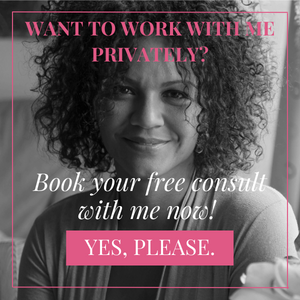
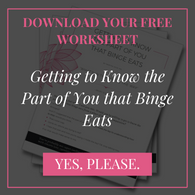
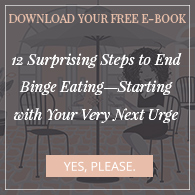

















0 Comments